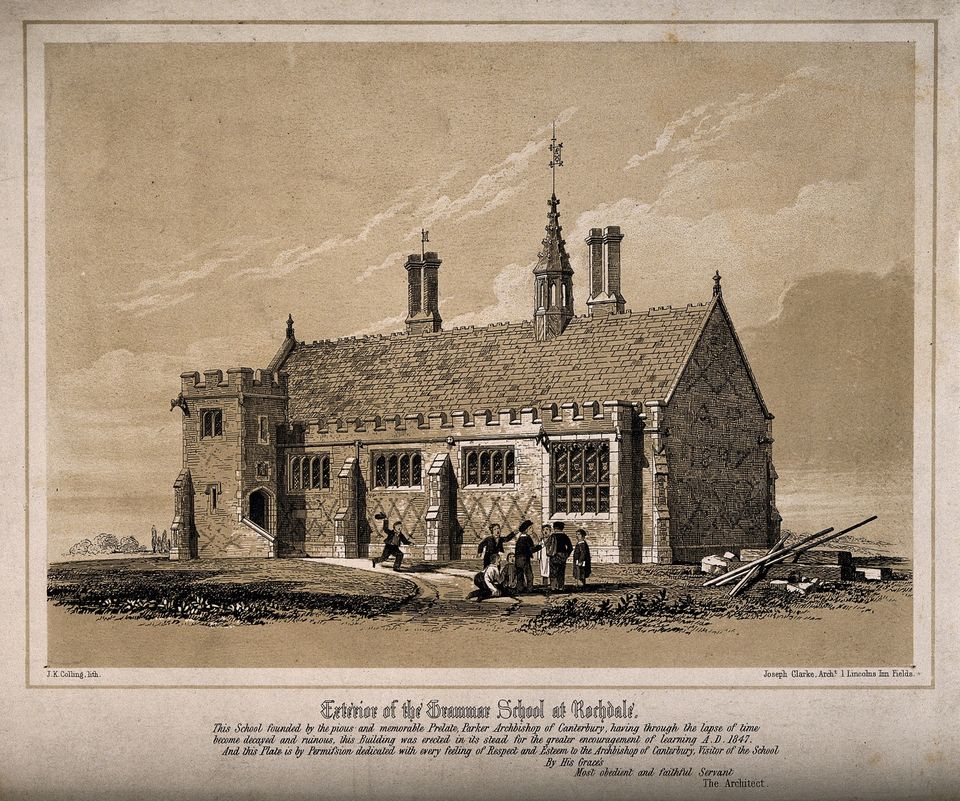The First Rochdale Boys Grammar School

In the mid 1500’s the town of Rochdale had a population of 10,000 most of whom had no education and would count themselves lucky to receive an apprenticeship. The few who could afford to have their sons well educated (and it was mainly sons), sent them to Whalley Abbey whilst poorer families were reliant on their children’s labour and therefore saw no use in schooling. The reformation in the 16th century saw a move away from schools connected to the church to the establishment of grammar schools in towns. Even so, when such a school was proposed in Rochdale in 1561 it came through the auspices of the Anglican church, Matthew Parker, the Archbishop of Canterbury, sending a letter to the inhabitants of Rochdale proposing the endowment of just such a school.
Although the town was keen to see a school built, the church at the time had little finance to make it happen. However, there was a proposal that funds be raised and this was forthcoming partly through the guarantor help of Sir John Byron (Steward of Manchester and Rochdale) and Mr Midgely, a local vicar who not only gave up part of his stipend but offered the site for the school opposite the churchyard. The foundation deed was completed by three parties, Archbishop Parker, Dr Porie (Master of Corpus Christi College, Cambridge) and Richard Midgely with the intention of ‘providing true piety and the study of the Latin tongue.’
Building was completed in 1565, the structure being, according to Reverend F R Raines in 1843, a ‘humble structure of one storey’. Built sixty feet by twenty in rough stone and covered by heavy flag slates it was situated by the Parish Church at the junction of Church Lane, still called ‘School Lane.’ At the South end of the interior was an oak desk for the Master whilst the rest of the room comprised of benches and desks for the students. Adjoining the school house was a raised, one-room building which acted as the Master’s House.
It was intended that the first Grammar School should house between 50-150 boys although the first intake was only 30. Lessons in Latin and the study of Christianity were the mainstay along with Greek, writing, arithmetic, history and geography. John Cole, writing in 1990 suggested that ‘the number of pupils attending the school was extremely small and the institution made little impact on general educational standards in the town.’ Although it was supposed to be free, should pupils want further subjects such as literature they had to pay a guinea and a half per quarter for the tuition. Furthermore, in order to be a member of the school, those who ‘are capable of benefitting’ had to pay a guinea entrance. Boarders were not taken. It was a requirement that the school be kept in good condition by the parishioners.
The Master’s stipend or salary was £15 per year, an under-Master or Usher receiving £2 per year. Financial contributions for this came from Charles Chadwick of Healey Hall and £13 10s from the Township of Butterworth. The first Master of Rochdale Grammar School was Reverend Robert Ratcliffe followed by Reverend Walkden in 1589 after which there was a succession of ministers of the church with the exception of Mr Richard Holte in 1605 although he too reputedly owned a large collection of theological books.
By the mid 19th century pupil numbers were small at the school, only 15 in 1862 and 31 in 1867 studying a curriculum consisting of English, Arithmetic, History and Geography, Geometry and Algebra, Linear drawing and copying from nature and Languages (Latin, Greek, French and German). The full charge for this education was 6 guineas per annum. A second Master was employed in later years and the school – serving boys aged 8-14 – was divided into junior and secondary schools, a few boarders being accepted. It seems that poor numbers from the grammar school entering Oxford or Cambridge was, according to Winter, ‘not remarkable,’ many students leaving the school to go to other universities in order to engage in commercial and professional employment. Behaviour in classes was thought to be good with only a ‘small amount of punishment needed.’ Headmasters in the 19th century still came from the clergy, Reverend Sheffield for example being appointed by the Archbishop of Canterbury.
By 1845 the original building was in a state of dilapidation and funds were found quite quickly to build a new Grammar School, partly by public funds raised through a bazaar. The new school was built on the site of the present Broadfield Hotel (once the nurse’s home) on Sparrow Hill in 1846, the original school being demolished in 1847.